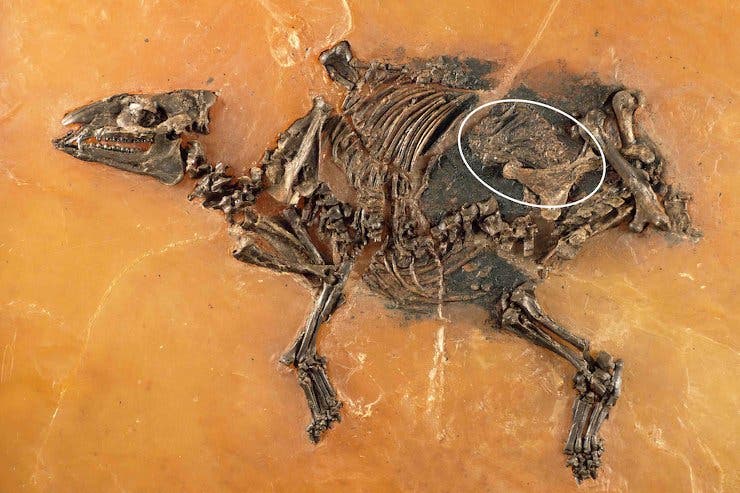Geologists analyzing 47 million year old remains of a mare believe they have figured out not only what brought the mare’s demise, but also how early horses looked like and behaved – they were strikingly similar to today’s horses, but much smaller.
A paleontologist’s gold mine

The pregnant mare suffered a sad faith – while she was taking a sip of water from a freshwater lake, she was unaware of the poisonous volcanic gases in the lake; this is what brought her demise – at least that’s what Jens Lorenz Franzen, a researcher at the Senckenberg Research Institute in Frankfurt believes.
But paleontologists soon found another surprise – the mare was pregnant, the unborn foal still inside its mother’s body.
“It’s magnificently preserved,” Franzen said. “It turned out this was an almost complete and articulated skeleton with a fetus.”
The fossil was found in the Messel pit – a famous area for fossil hunters and paleontologists, who have uncovered hundreds of interesting fossils since the early 1900s. The findings include mating turtles, moths and lizards. The area was extremely dangerous for animals, but it created excellent fossilization techniques. The area was basically a lake surrounded by poisonous volcanic gases. Many animals succumbed to the gases and fell into the lake, becoming embedded in the muddy sediments. There, anaerobic bacteria decomposed the skin, organs and muscles, but preserved the bones, by creating a petrified layer of bacterial residue around the bones. These conditions are extremely rare, and are basically a gold mine for paleontologists because they allow envisioning the fossils at incredible resolution.

“The bacteria helped a lot and in a very wonderful way,” Franzen said. When they looked at the mare with the high-resolution X-ray, the scientists can see the “tips of hairs of the outer ears — even the interior, like blood vessels, become visible in some cases,” he said.
An amazing fossil
Finding complete horse fossils, especially as old as this one is very rare. Speaking at the annual meeting of the Society of Vertebrate Paleontology in Berlin this past November 6, Franzen said that Germany’s Messel Pit has so far yielded hundreds of fossils, but this one is definitely among the most interesting. The fossil’s condition was so good that not only are all the bones preserved, but you can also see the ligament supporting the development of the fetus is.
“Almost all of the bones of the fetus are still articulated in their original position,” study lead author Jens Lorenz Franzen told the press in a recent interview. “Only the skull is crushed,” the Senckenberg Research Institute scientist added.
Indeed, it’s exceptional to find any mammal fossil in this state, let alone a horse fossil. Bruce MacFadden, a distinguished professor and curator of vertebrate paleontology at the University of Florida, who was not involved in the study was excited to see the results.
“Completely preserved skeletons of fossil horses are rare,” MacFadden told Live Science. “Usually, they’re fragmented and the bones are all dissociated. If you find a skeleton with a preserved foal inside, that indicates exceptional preservation, which is normally not found in the fossil record.”
A glimpse into the past
Even though the fossil shows striking similarities with today’s horses, it is incredibly small – about the size of a small dog, like a Fox Terrier. It was basically a miniature horse. Keep in mind, this animal lived closer to T-Rex than to humans.
As I said above, using X-rays, researchers were able to see the broad ligament, a structure that connects the horse’s uterus to the backbone and helps the fetus develop. The X-ray also showed traces of the animal’s crumpled outer uterine wall, a feature that still exists in modern horses. Also, they were also able to study the fetus, and learned that it was almost entirely developed – it even had milk teeth.
To me, this is a very intriguing find. It shows that horses have remained almost unchanged in anatomy, except for the fact that they have grown; and they have grown a lot! Few mammals have remained unchanged for 50 million years, and there’s still so many things we have yet to learn about them. For example, it’s still not clear exactly why horses started to grow more and more. It may have happened because they wanted to outrun their predators, due to climate change, or simply because with the demise of dinosaurs, there were more resources available.
The findings were presented Thursday (Nov. 6) at the 2014 annual meeting of the Society of Vertebrate Paleontology in Berlin.






